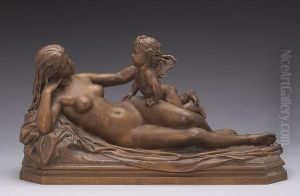Gustave Crauk Paintings
Gustave Crauk was a French sculptor born on February 16, 1827, in Valenciennes, a commune in the Nord department in northern France. Known for his classical style, Crauk's work was part of the academic art movement of the 19th century, which emphasized traditional forms and techniques, and often took themes from history and mythology.
Crauk studied at the École des Beaux-Arts in Paris, where he was a pupil of the renowned sculptor David d'Angers. He honed his craft under this tutelage and began to gain recognition for his talents. In 1849, he won the prestigious Prix de Rome for sculpture, which allowed him to study at the French Academy in Rome, the Villa Medici. His time in Italy had a profound influence on his artistic development. He absorbed the classical tradition, which became a cornerstone of his sculptural style.
Upon his return to France, Crauk established himself as a prominent sculptor. He received numerous commissions for public monuments and decorative sculpture, reflecting the tastes and aspirations of the time. His works were characterized by their refined execution and often idealized forms. Crauk was also involved in the restoration of sculptures in historic buildings, contributing to the preservation of France's cultural heritage.
One of his most famous works is the 'Valenciennes Defense Against the Duke of Burgundy' (1878), a powerful bronze group that shows the city of Valenciennes resisting Charles the Bold in 1477. This piece is notable for its dynamic composition and emotional intensity, representing the spirit of resistance and patriotism.
Crauk continued to work and receive honors throughout his career. He was made a Knight of the Legion of Honor in 1852 and was promoted to Officer of the order in 1885, which was a testament to his standing in the French artistic community.
Gustave Crauk's commitment to classical sculpture remained steadfast even as the art world around him began to shift towards modernism. Despite the changing trends, his work retained a sense of timelessness and continued to be respected for its craftsmanship and beauty. Crauk passed away on December 15, 1905, in Paris, leaving behind a legacy of work that still stands as a testament to the academic tradition in French sculpture.
